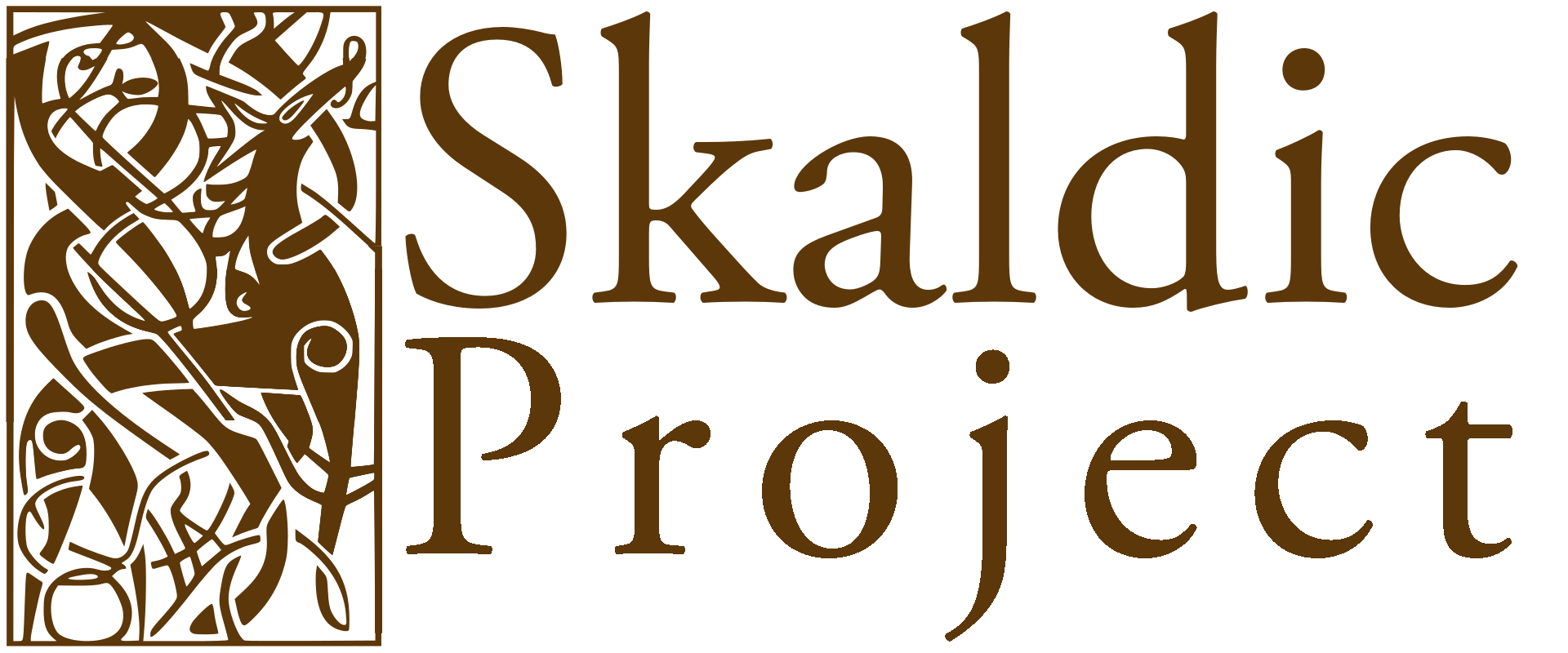Anon (FoGT) 15III
Margaret Clunies Ross (ed.) 2017, ‘Anonymous Lausavísur, Stanzas from the Fourth Grammatical Treatise 15’ in Kari Ellen Gade and Edith Marold (eds), Poetry from Treatises on Poetics. Skaldic Poetry of the Scandinavian Middle Ages 3. Turnhout: Brepols, p. 588.
After st. 14. which concludes FoGT’s exemplification of prosopopoeia, there follows a chapter on the rhetorical figure of apostropha, or direct address, often to an absent or imaginary person. This is exemplified by SnSt Lv 6 and the two couplets Ólhv Thómdr 1-2. The following chapter, which contains sts 15 and 16, describes the figure of hendiadys.
Skálm vann og hjalt hilmi
hoddbeiðöndum reiðan.
Skálm og hjalt vann hilmi reiðan {hoddbeiðöndum}.
Point and hilt made the ruler angry {with the gold-requesters} [MEN].
Mss: W(113) (FoGT)
Readings: [1] Skálm: Skamm W; og: ef W
Editions: Skj AII, 216, Skj BII, 233, Skald II, 121; SnE 1848-87, II, 206-7, III, 157, FoGT 1884, 128, 257-8, FoGT 2004, 37, 65, 105-6, FoGT 2014, 14-15, 74.
Context: See Introduction to sts 15 and 16. FoGT introduces hendiadys thus: Endiadís er sv figura, er .ij. svndr lauser lvter erv merkter fyrer einn vskiptíligan lvt, ęðr einn vskiptíligr lutr er settr fyrer .ij. skiptiligvm lutvm, ok er hon vnder dregín samfesting lavssa luta okleysing fastra lvta, sem her ‘Hendiadys is that figure where two separate entities are mentioned instead of a single indivisible entity, or one indivisible entity is used for two divisible entities, and it is governed by the fastening together of free entities and the separation of entities that are held fast, as here’. Stanza 15 then follows.
Notes: [All]: This dróttkvætt couplet provides a good example in support of the surmise that the scribe of W was not the author or redactor of FoGT. If he had been, he would surely have realised that his ‘skamm’ and ‘ef’ in l. 1 were incorrect, as the correct forms, skálm ‘point’ [of a sword]’ and og ‘and’ are given in the prose text immediately following the stanza viz.: her er v skiptiligr lvtr sverðit merkt fyrer skalm okhiallt, svndr lavsa lvtí ‘here an indivisible entity, the sword, is signified by point and hilt, separate entities’. — [1] vann ‘made’: The finite verb is in the sg., but it has a pl. subject (cf. NS §§70-1). — [1] hjalt ‘hilt’: This long, trimoraic nomen in metrical position 4 of an XE4 line is a sign of a late date of composition (C14th).
References
- Bibliography
- SnE 1848-87 = Snorri Sturluson. 1848-87. Edda Snorra Sturlusonar: Edda Snorronis Sturlaei. Ed. Jón Sigurðsson et al. 3 vols. Copenhagen: Legatum Arnamagnaeanum. Rpt. Osnabrück: Zeller, 1966.
- Skald = Kock, Ernst Albin, ed. 1946-50. Den norsk-isländska skaldediktningen. 2 vols. Lund: Gleerup.
- NS = Nygaard, Marius. 1906. Norrøn syntax. Kristiania (Oslo): Aschehoug. Rpt. 1966.
- FoGT 1884 = Björn Magnússon Ólsen, ed. 1884. Den tredje og fjærde grammatiske afhandling i Snorres Edda tilligemed de grammatiske afhandlingers prolog og to andre tillæg. SUGNL 12. Copenhagen: Knudtzon.
- FoGT 2004 = Longo, Michele, ed. [2004]. ‘Il Quarto Trattato Grammaticale Islandese: Testo, Traduzione e Commento’. Dottorato di Ricerca in ‘Linguistica Sincronica e Diacronica’ (XV Ciclo). Palermo: Università degli Studi di Palermo, Facoltà di Lettere e Filosofia.
- FoGT 2014 = Clunies Ross, Margaret and Jonas Wellendorf, eds. 2014. The Fourth Grammatical Treatise. University College London: Viking Society for Northern Research.
- Internal references
- (forthcoming), ‘ Unattributed, The Fourth Grammatical Treatise’ in Kari Ellen Gade and Edith Marold (eds), Poetry from Treatises on Poetics. Skaldic Poetry of the Scandinavian Middle Ages 3. Turnhout: Brepols, p. . <https://skaldic.org/m.php?p=text&i=34> (accessed 15 May 2024)
- Guðrún Nordal (forthcoming), ‘ Snorri Sturluson, Lausavísur’ in Guðrún Nordal (ed.), Poetry on Icelandic History. Skaldic Poetry of the Scandinavian Middle Ages 4. Turnhout: Brepols, p. . <https://skaldic.org/m.php?p=text&i=1378> (accessed 15 May 2024)
- Margaret Clunies Ross (ed.) 2017, ‘Óláfr hvítaskáld Þórðarson, Thómasdrápa 1’ in Kari Ellen Gade and Edith Marold (eds), Poetry from Treatises on Poetics. Skaldic Poetry of the Scandinavian Middle Ages 3. Turnhout: Brepols, p. 301.
Stanza/chapter/text segment
Use the buttons at the top of the page to navigate between stanzas in a poem.
Information tab
- text: if the stanza has been published, the edited text of the stanza and translation are here; if it hasn't been published an old edition (usually Skj) is given for reference
- sources: a list of the manuscripts or inscriptions containing this stanza, with page and line references and links (eye button) to images where available, and transcription where available
- readings: a list of variant manuscript readings of words in the main text
- editions and texts: a list of editions of the stanza with links to the bibliography; and a list of prose works in which the stanza occurs, allowing you to navigate within the prose context
- notes and context: notes not linked to individual words are given here, along with the account of the prose context for the stanza, where relevant
Interactive tab
The text and translation are given here, with buttons to toggle whether the text is shown in the verse order or prose word order. Clicking on indiviudal words gives dictionary links, variant readings, kennings and notes, where relevant.
Full text tab
This is the text of the edition in a similar format to how the edition appears in the printed volumes.
Chapter/text segment
This view is also used for chapters and other text segments. Not all the headings shown are relevant to such sections.
